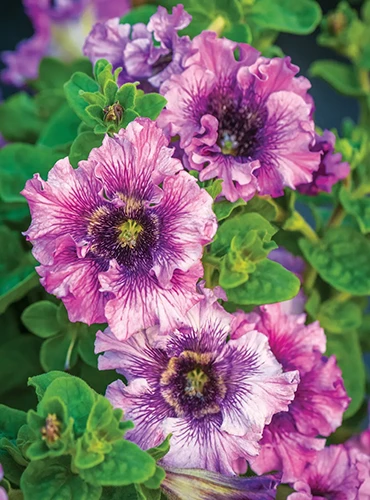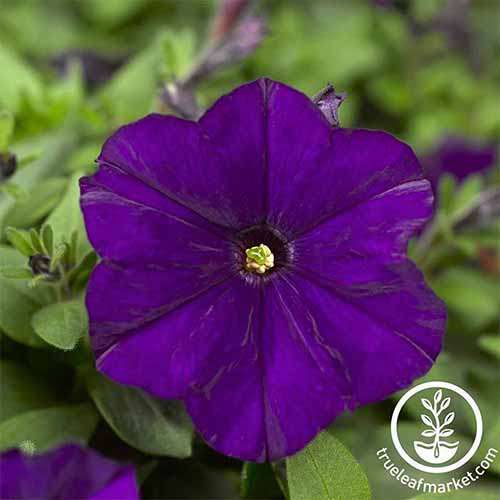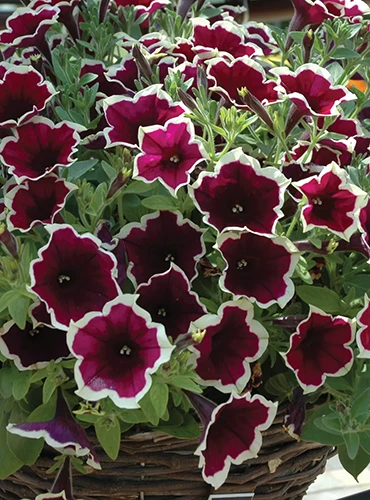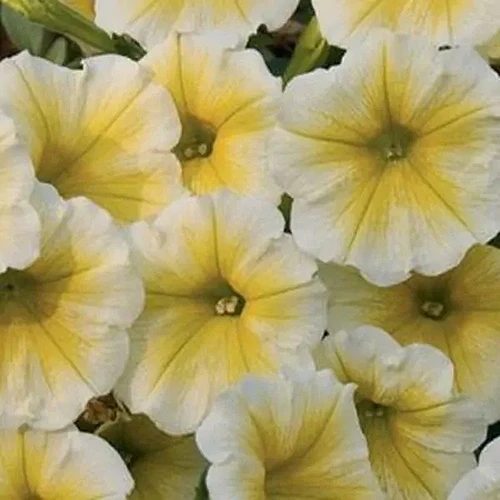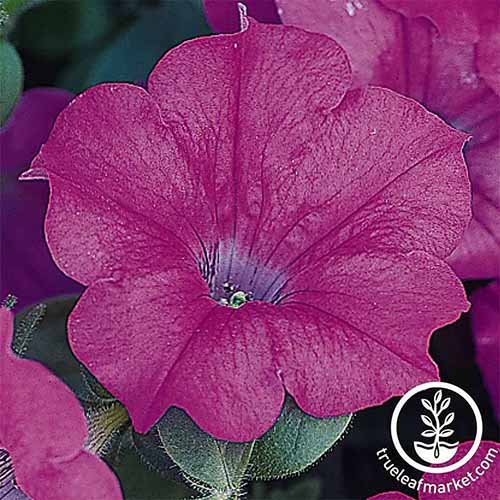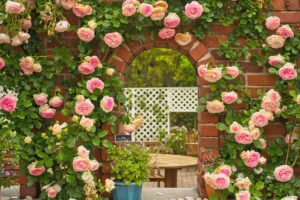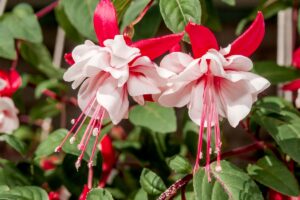One of the most popular annual flowers, easy-care petunias thrive in containers – and pots and planters make a beautiful framework to showcase these exuberant ornamentals.
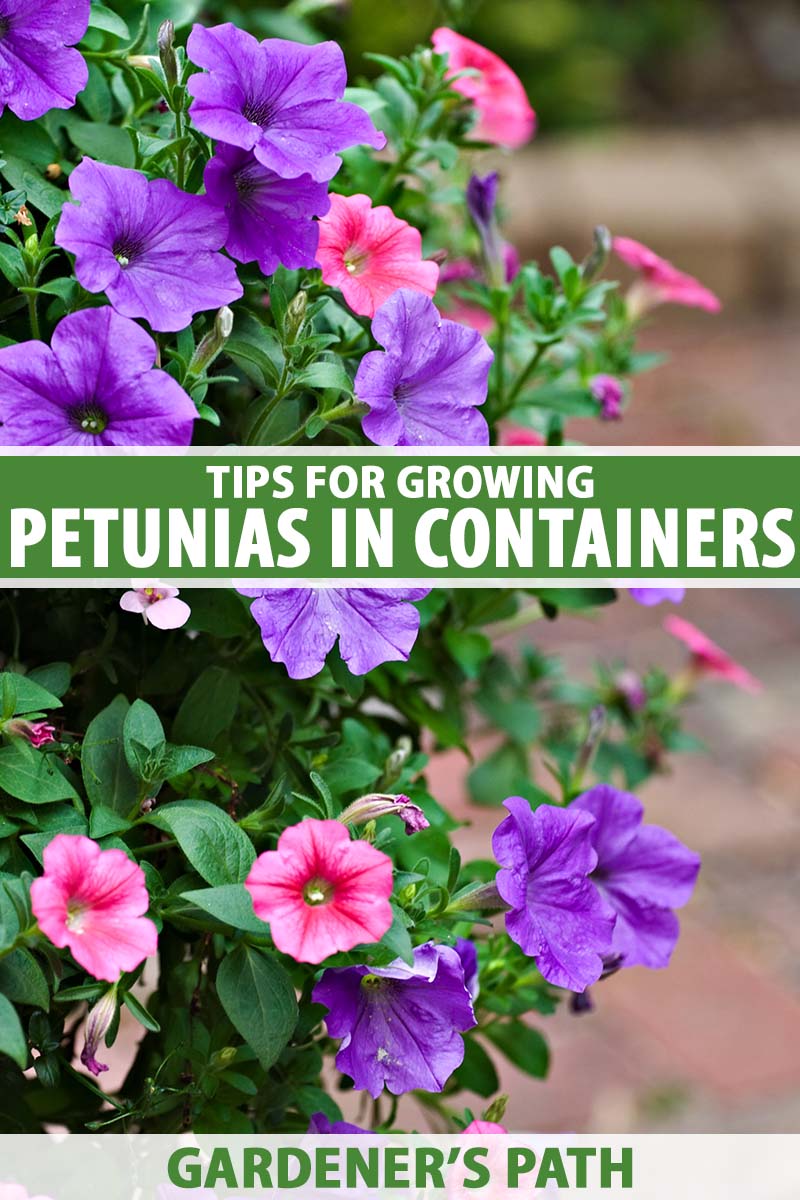
We link to vendors to help you find relevant products. If you buy from one of our links, we may earn a commission.
Forming handsome mounds for patio pots or cascading over the edges of hanging baskets and window boxes, these highly floriferous plants give a nonstop parade of densely packed, trumpet-shaped flowers from early summer until frost.
Striking when mass planted on their own, they also make a superb addition to mixed plantings, giving fast, luxurious growth and continuous flowers over a long season.
And the colors!
Available in a huge array of bright, bold colors, with solid tones, bicolors, freckles, mottling, and stripes as well, the long color list includes multiple variations of burgundy, mauve, magenta, orange, peach, pink, purple, red, salmon, scarlet, white, and yellow.
You can find almost every shade imaginable, even blacks and blues!
Size and form vary as well, from the showy and large-flowered grandifloras to the elegant spreading varieties that require no deadheading.
Many of today’s hybrids are not fragrant, but there are still plenty that offer the sweetly spicy fragrance of old-fashioned cultivars – a captivating scent on the summer’s breeze if you enjoy perfumed blooms.
Easily cultivated plants, the flowers are highly attractive to many pollinators including bees, butterflies, and hummingbirds.
Want to grow some pretty potted petunias this summer? Then let’s jump in! Here’s what you’ll find in our guide to petunia container care:
What You’ll Learn
Containers and Planting
Containers offer an excellent way to create small gardens or to extend your garden into non-arable hardscape settings such as decks and patios, concrete slabs, gravel areas, stairs, stone pathways, and in front of foundations or retaining walls.
And petunias are the perfect plant to make any kind of garden pot look good!
Give them the conditions they love and they’ll grow in pots and planters of any size and type of material.

For lush growth with abundant flowers, the following guidelines produce beautiful displays:
Choose pots and planters with drainage holes. I cover these with a two-inch layer of loose material such as broken pottery or pebbles.
Fill the containers with a well-draining, fertile soil with a slightly acidic to neutral pH of 6.0 to 7.0.
To two parts of your favorite potting soil mix, add in one part of moisture-retentive materials such as coconut coir, peat moss, perlite, or vermiculite. Containers dry out quickly and these materials help to preserve soil moisture.
Enrich the soil with one part organic matter such as compost or well-aged manure – petunias are heavy feeders and benefit from fertile soil.
And for well-draining soil that doesn’t compact easily, add in one part grit such as landscape sand, pea gravel, perlite, or stone chips.
Finish off your container soil by mixing in one to two tablespoons of bone meal for fast and healthy root growth.
Set bedding plants in place with the crown just below the soil surface and spaced closer than in the ground.
As a container rule of thumb, you can space your bedding plants about one-third closer than for in-ground planting recommendations.
Backfill with soil and firm gently in place.
For moss-lined hanging baskets, before filling with soil, add a layer of perforated heavy plastic over the moss to help retain water. But be sure the plastic has several small holes punched in it so the soil can drain and doesn’t become soggy.
At the end of the growing season, in mid- to late autumn, lift plants and dispose of them in your compost or food waste bins. Or if your plants are still healthy and vibrant, you can also overwinter petunias.
Next, to really get the look you want, knowing a few traits of today’s most common types is helpful.
The Best Petunia Types for Containers
Petunia is a genus of about 20 species in the Solanaceae family, and most of the large selection available for home use are hybrids of Petunia axillaris and P. integrifolia, known as P. × hybrida (syn. P. x atkinsiana).
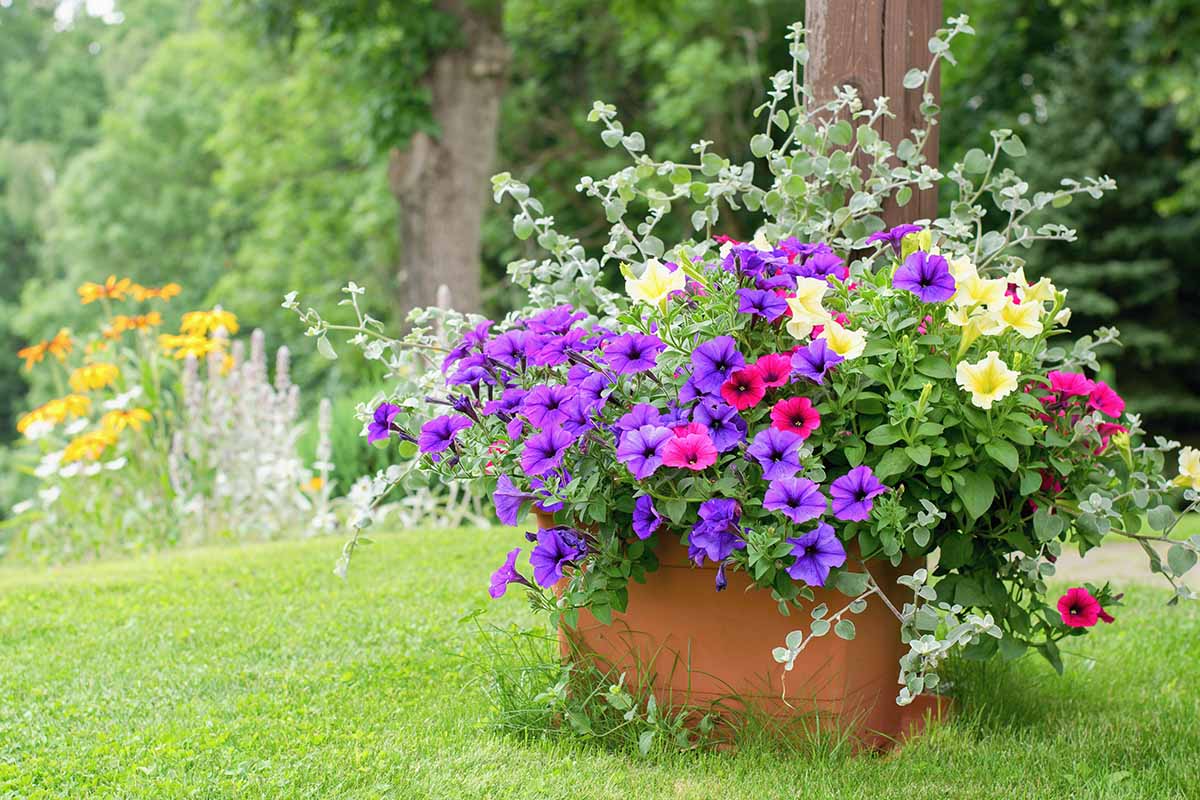
Native to South America, plants were first introduced to European gardens in the mid-1800s, and breeders have been continuously producing new types ever since.
Today, the prolific offspring of P. x hybrida are grouped into different types, according to flower size, plant size, and growth habits – and the list keeps growing!
Here’s a brief breakdown of the types you’ll currently find in garden shops.
Grandiflora
Grandifloras are the oldest cultivated hybrids, charmers with magnificent, large flowers up to four inches across in either single or carnation-like double forms.

Growth is mostly upright, forming attractive mounds of up to 15 inches, but the showy flowers are prone to rain damage – look for newer cultivars that are bred to handle wet weather.
Grandifloras have a clumping habit that are well-suited for garden beds, planters, and window boxes, with some trailing varieties that make a good fit for hanging containers as well.
‘Spellbound Pink’ is a mesmerizing grandiflora untroubled by wet weather. It features large, ruffled flowers of up to six inches in rich magenta pink with a dark center.
Seeds and plant bundles are available at Burpee.
Multiflora
Multiflora types have a more compact size than grandifloras with smaller flowers measuring about two inches.
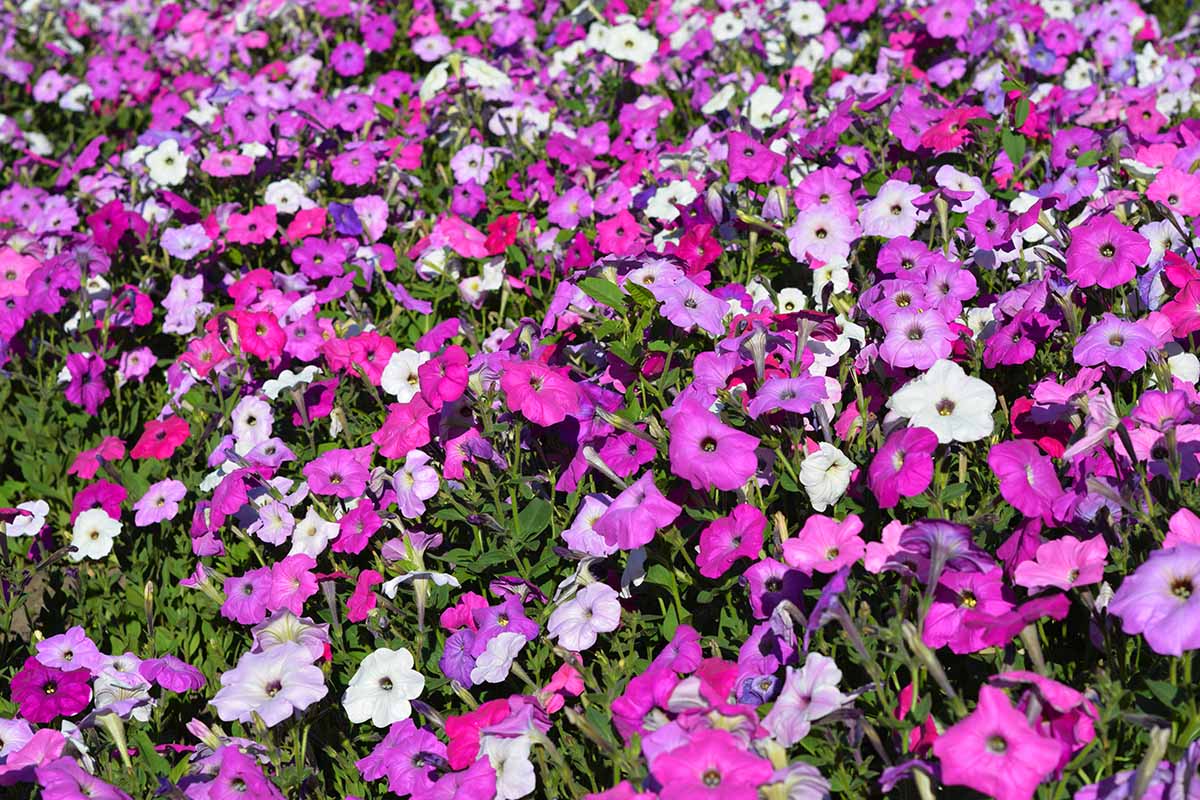
Fast-growing multifloras grow up to 12 inches tall with a spread of up to 15 inches and have improved heat and wet weather resistance.
Their mounding habit is terrific mass planted into beds, borders, and large planters, with a limited spread that’s fabulous for tidy window boxes.
The single or double flowers are available in a huge range of colors, and many varieties are self-cleaning and don’t require deadheading.
However, they can become a little leggy by midsummer and benefit from a light pruning to encourage branching and new growth. (See the Pruning section below for details.)
Floribundas are often included in this group and feature the improved heat and wet weather tolerance of multifloras with the larger flowers of grandifloras.
They grow up to 15 inches tall with a spread of up to 12 inches and require deadheading or pruning for the best flower displays.
The ‘Garden Party’ blend is a floribunda mix with three-inch flowers in pretty shades of mauve, peachy pink, and rosy magenta.
Seed packets are available at Botanical Interests.
Milliflora
Introduced in the late 1990s, millifloras are dwarf plants with masses of small, single flowers measuring up to one and a half inches.
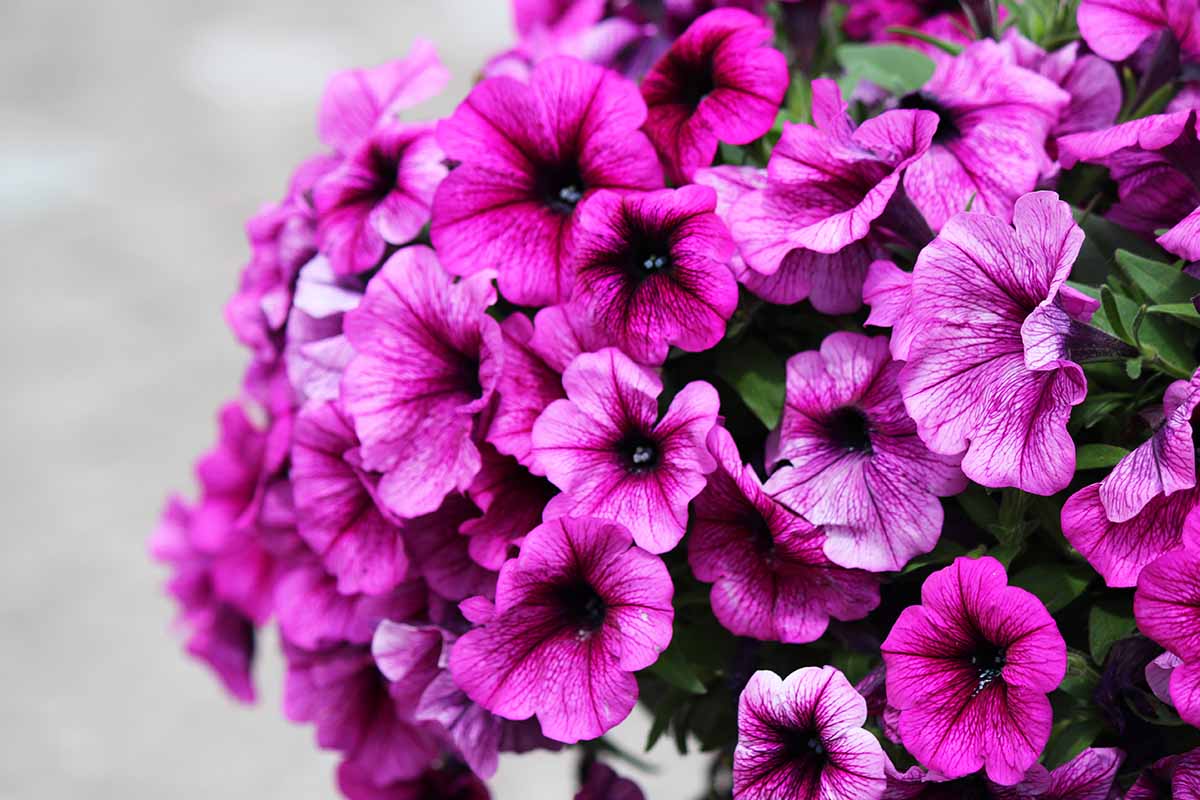
Plants are self-cleaning with compact, mounding growth.
They reach a height of only eight inches but some varieties spread as much as 48 inches and make a superb choice for beds, borders, and ground covers as well as spilling from containers and planters.
The Picobella™ series produces dwarf plants with a 12-inch spread and two- to three-inch flowers.
Pelleted seeds in a variety of colors are available at True Leaf Market.
Spreading
Spreading varieties are a development from the late 20th century bred for a spreading or trailing habit – making them the go-to choice for long, tumbling trails.
The most successful of these types include Cascadias™, Surfinia®, Supertunia®, and Wave® varieties.
They make lush ground covers and are simply sumptuous spilling out of hanging baskets, patio pots, and window boxes.
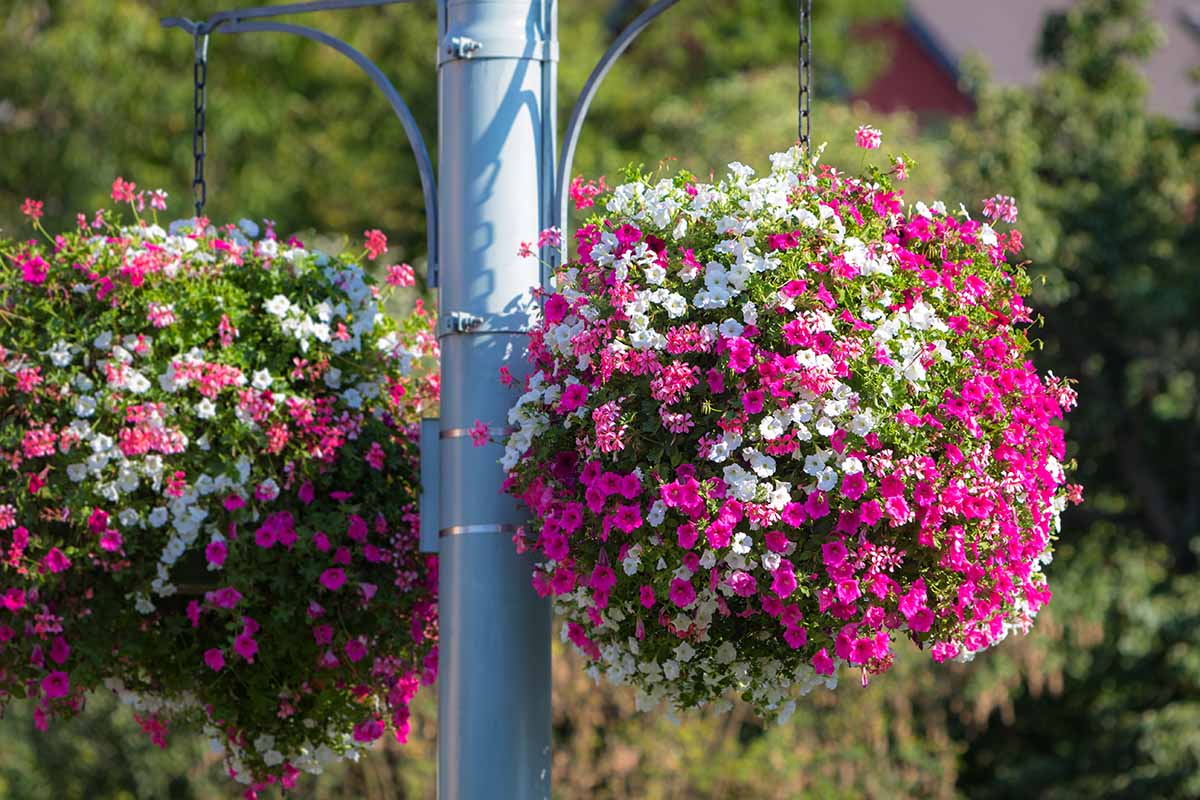
The spreading types also have good heat and drought tolerance and are self-cleaning, so they require no deadheading.
Cascadias™ and Surfinia® are densely branched, highly floriferous plants, featuring masses of single, two-inch flowers in vivid colors with a good tolerance for heat and wet weather.
Cascadias™ plants grow up to 12 inches and spread as much as 20 inches, and Surfinia® plants grow up to eight inches with some varieties boasting a trail or spread of as much as 55 inches.
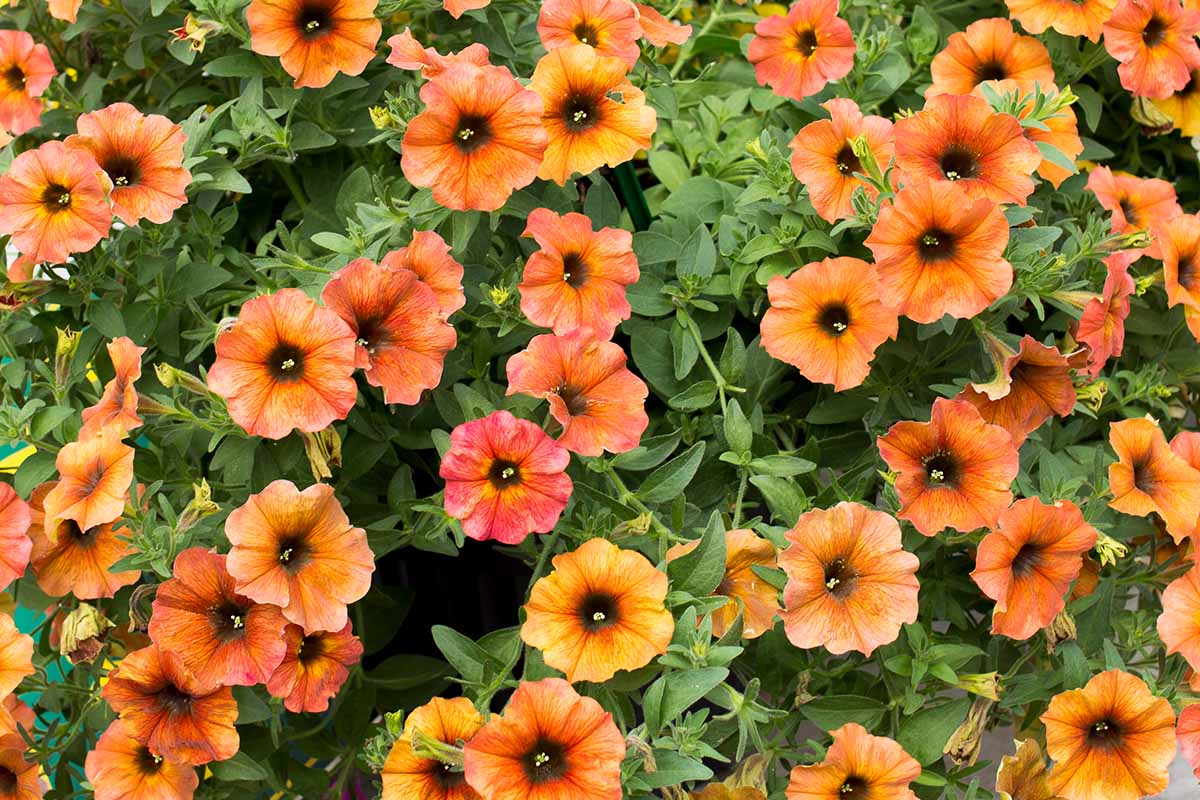
Supertunia® is another self-cleaning and spreading type with excellent heat and humidity tolerance that also makes a superb performer for spilling or trailing out of containers.
These showy plants have single or double flowers that measure up to two inches across.
Highly branched, the plants reach a height of up to 10 inches with a magnificent spread or trail of up to 36 inches.
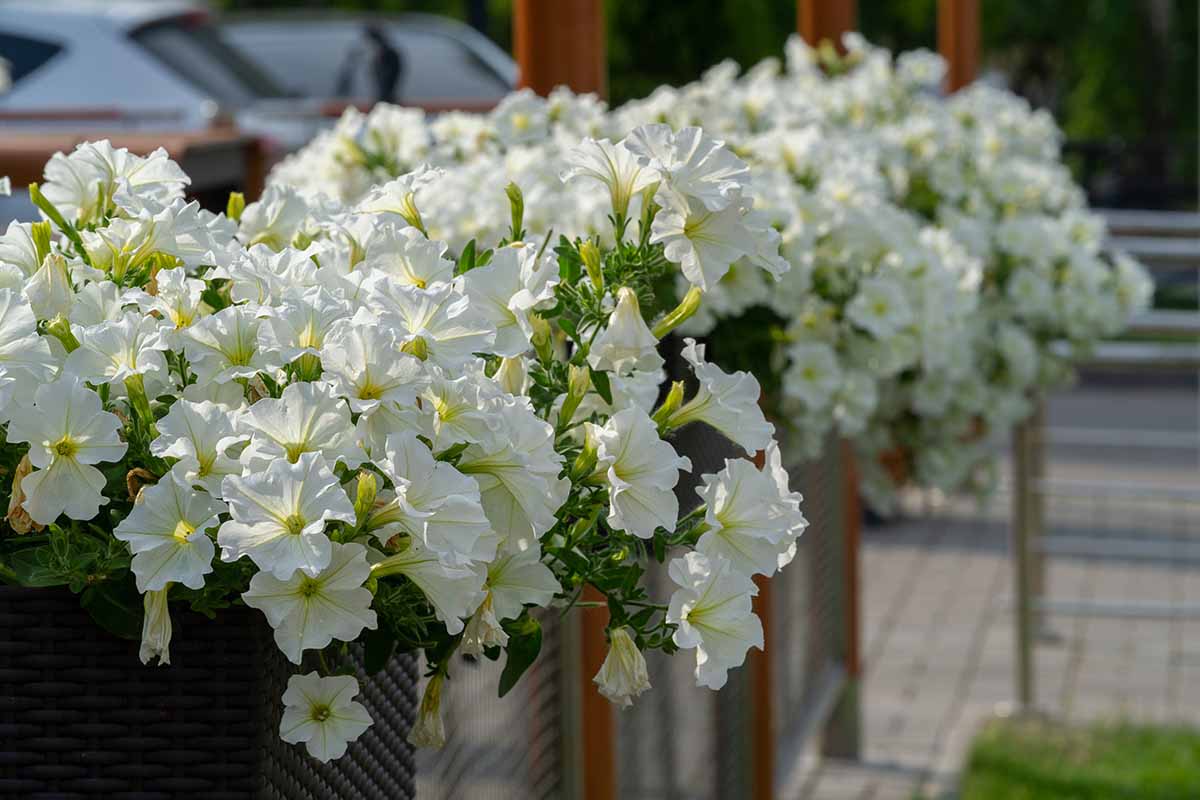
Wave® hybrids grow to only six inches tall but have a luxurious trail or spread up to 48 inches.
However, flowering can lag in summer’s heat. To rejuvenate these plants, give them a light pruning in midsummer to revitalize flower production.
‘Rim Magenta’ is a Cascadias™ hybrid with two-inch, deep burgundy flowers boldly edged in white on plants that trail up to 20 inches.
Plant bundles can be found at Burpee.
Supertunia® seeds like ‘Citrus,’ with one- to two-inch flowers of lemony yellow and white on plants that spread up to 12 inches, are available at Nature Hills Nursery.
Pelleted seeds of the Wave® types, with a strong spread of 24 to 48 inches, are available in ‘Lavender,’ ‘Pink,’ ‘Purple,’ and ‘Misty Lilac’ at True Leaf Market.
For a better understanding of these groups and more cultivar suggestions, check our guide on the different types of petunias.
Do Petunias Need Deadheading?
Deadheading requirements depend on the type of petunia.
Old-time varieties such as the grandifloras benefit from deadheading to prevent seeding.
But many of the newer types, like Supertunia® cultivars, are entirely self-cleaning and require no deadheading. Check your seed packet or planting instructions to determine if yours are self-cleaning.

If your plants do need deadheading, it’s fast and easy and a task that’s best performed weekly.
Once the flowers are faded and wilted, remove the spent blooms by pinching out with your thumb and forefinger, or use a clean, sharp thumb knife or shears to cut them out.
Try this silicone thumb knife set with protective index finger covers, available on Amazon in small or large.

Be sure to cut the stem below the small sepals at the flower’s bottom – you want to remove the small round ovary that will form the seeds, which sits at the base of the petals.
Always cut the stems cleanly and don’t try to pull them off. Pulling is an easy way to break stems and even uproot plants.
When and How to Fertilize
Petunias are heavy feeders, and to keep containers looking great, they typically need more frequent feedings than those planted in ground.
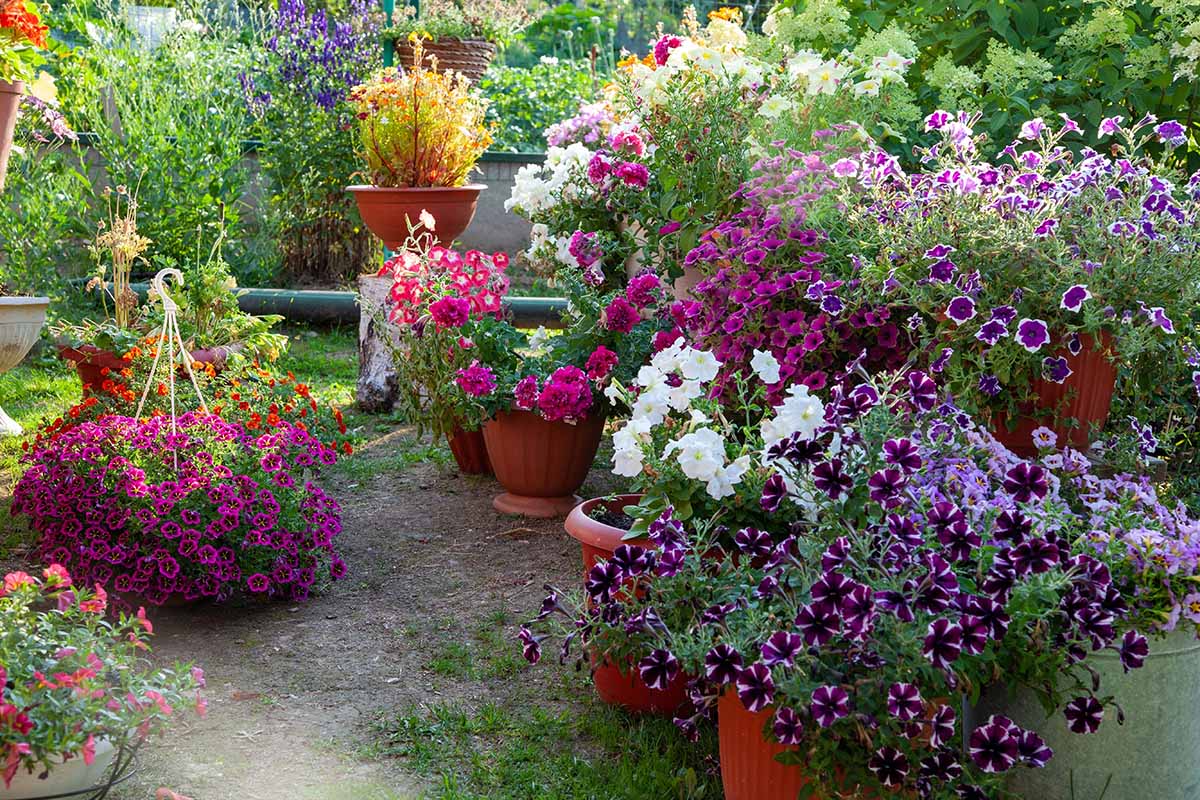
Enrich the soil at planting time by mixing in a few handfuls of compost or aged manure.
After planting, use an all-purpose liquid or water-based fertilizer or slow-release pellets, with a balanced formula like 10-10-10 NPK.
Liquid or water-based fertilizers are best applied to containers every two weeks, but at only half strength. This supplies plants with the nutrients they need without promoting leggy growth.
For fast, even uptake of nutrients, ensure the soil is slightly moist before applying liquid fertilizers.
For slow-release pellets, scatter over the soil surface right after planting and reapply in early summer.
Prune for Full Plants
Although they’re definitely low-maintenance, petunias give the best floral displays with a bit of selective pruning – but use a light touch as plants shouldn’t be cut back hard.
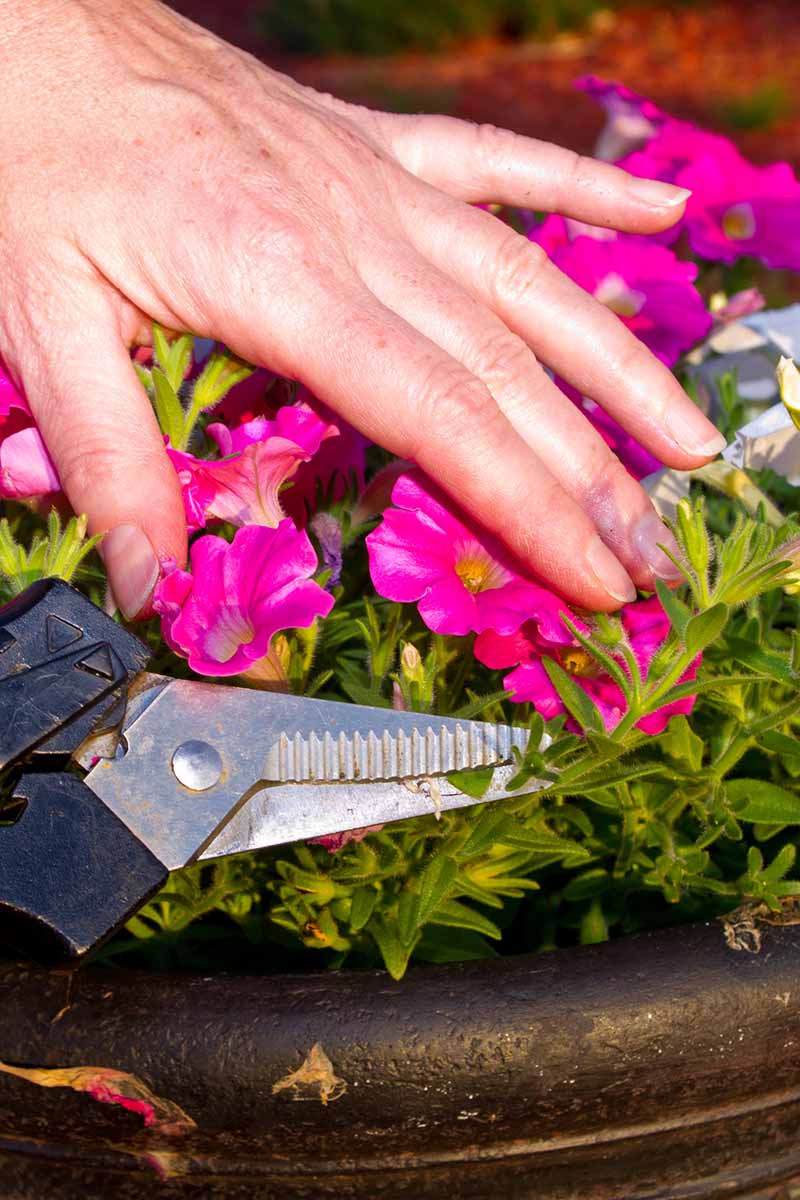
Pruning lightly encourages new growth with more flowers, keeping plants tidy with a full form.
All types have their most vigorous growth in late spring, so the best time to prune is right after that, or around the start of July.
Select any stems that are getting leggy and use clean, sharp garden shears to cut them back by up to one-third, taking off just enough to reshape plants to have a pleasing appearance.
Reshape again in mid-August, or any time stems start to elongate with flowers only at the tips.
Pruning beyond mid-September doesn’t usually produce any significant new growth.
Sun Exposure
Place your heat-loving, potted petunias in a full sun location with at least six hours of sunlight per day.
They can tolerate light shade but won’t develop the same volume of flowers as in full, direct light.
Watering Needs
Water regularly, providing up to two inches of water per week.
Because containers dry out quickly in full sun or windy conditions, you might need to water two or three times per week – and small containers may need daily watering in hot spells.
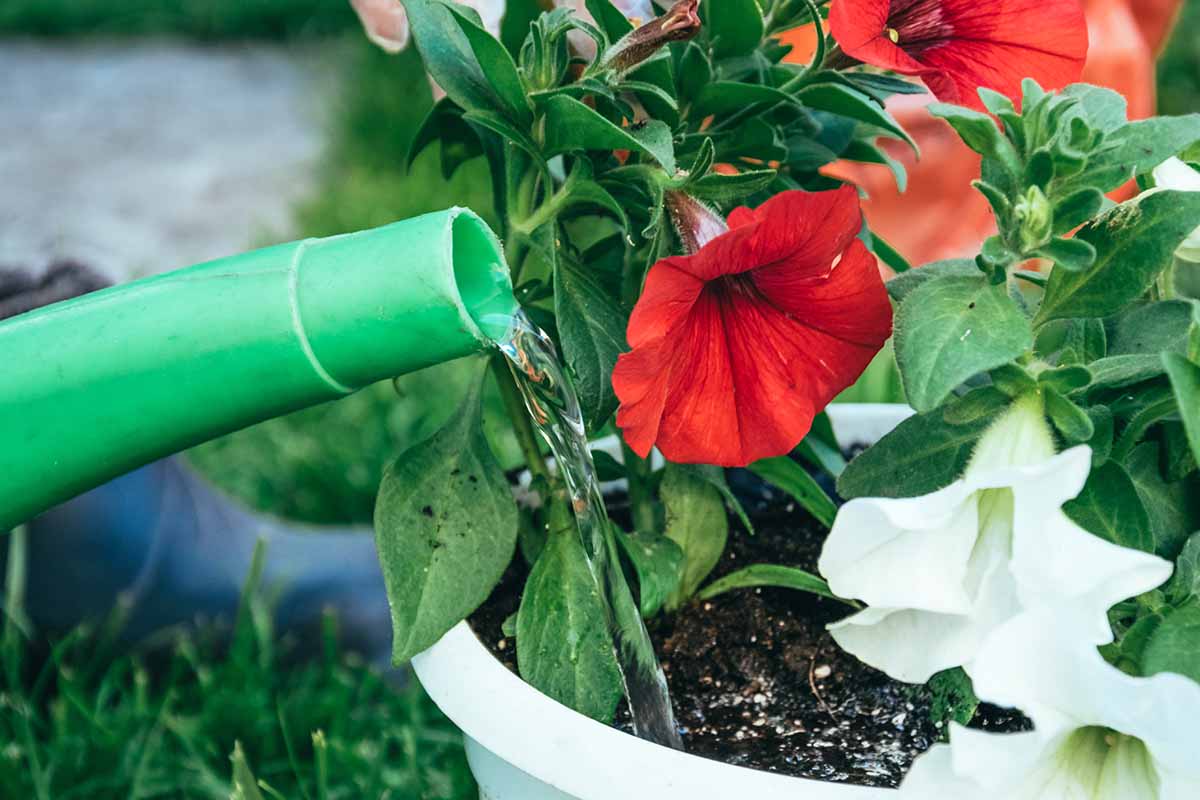
Water deeply to promote deep root growth but don’t allow soil to become oversaturated or waterlogged, and empty catchment trays if the soil is wet.
Allow the top inch of soil to dry out between water applications.
Also, it’s helpful to avoid overhead watering to reduce the spread of pathogens like the fungi that cause powdery mildew.
Pests and Problems
Most of the varieties now available are bred for good disease resistance, but pests and diseases like aphids, deer, or powdery mildew are just as likely to strike potted plants as those grown in-ground.

To manage nuisances like aphids, herbivores, or leaf miners, check our guide on common petunia pests.
And to deal with diseases like powdery mildew or mosaic virus, refer to our guide on how to grow and care for petunias.
Pretty Potted Petunias
With their fantastic colors, long flowering season, and beautiful forms, petunias are a knockout in containers of any shape or size.

Use the mounding varieties for large patio containers and the trailing ones for hanging baskets and window boxes.
For a fantastic show of flowers all summer, water and feed containers regularly and remember to prune plants if they become leggy – you’ll love their showy performance with this basic care!
What type of petunias do you folks grow in containers? Let us know in the comments section below.
And for more petunia know-how, add these guides to your reading list next:
